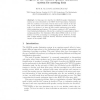Free Online Productivity Tools
i2Speak
i2Symbol
i2OCR
iTex2Img
iWeb2Print
iWeb2Shot
i2Type
iPdf2Split
iPdf2Merge
i2Bopomofo
i2Arabic
i2Style
i2Image
i2PDF
iLatex2Rtf
Sci2ools
CLEAR
2007
Springer
2007
Springer
Progress in the AMIDA Speaker Diarization System for Meeting Data
In this paper we describe the AMIDA speaker dizarization system as it was submitted to the NIST Rich Transcription evaluation 2007 for conference room data. This is done in the context of the history of this system and other speaker diarization systems. One of the goals of our system is to have as little tunable parameters as possible, while maintaining performance. The system consists of a BIC segmentation/clustering initialization, followed by a combined re-segmentation/cluster merging algorithm. The Diarization Error Rate (DER) result of our best system is 17.0 %, accounting for overlapping speech. However, we find that a slight altering of Speech Activity Detection models has a large impact on the speaker DER.
AMIDA Speaker Dizarization | Biometrics | CLEAR 2007 | NIST Rich Transcription | Speaker Diarization Systems |
| Added | 07 Jun 2010 |
| Updated | 07 Jun 2010 |
| Type | Conference |
| Year | 2007 |
| Where | CLEAR |
| Authors | David A. van Leeuwen, Matej Konecný |
Comments (0)

